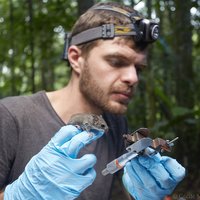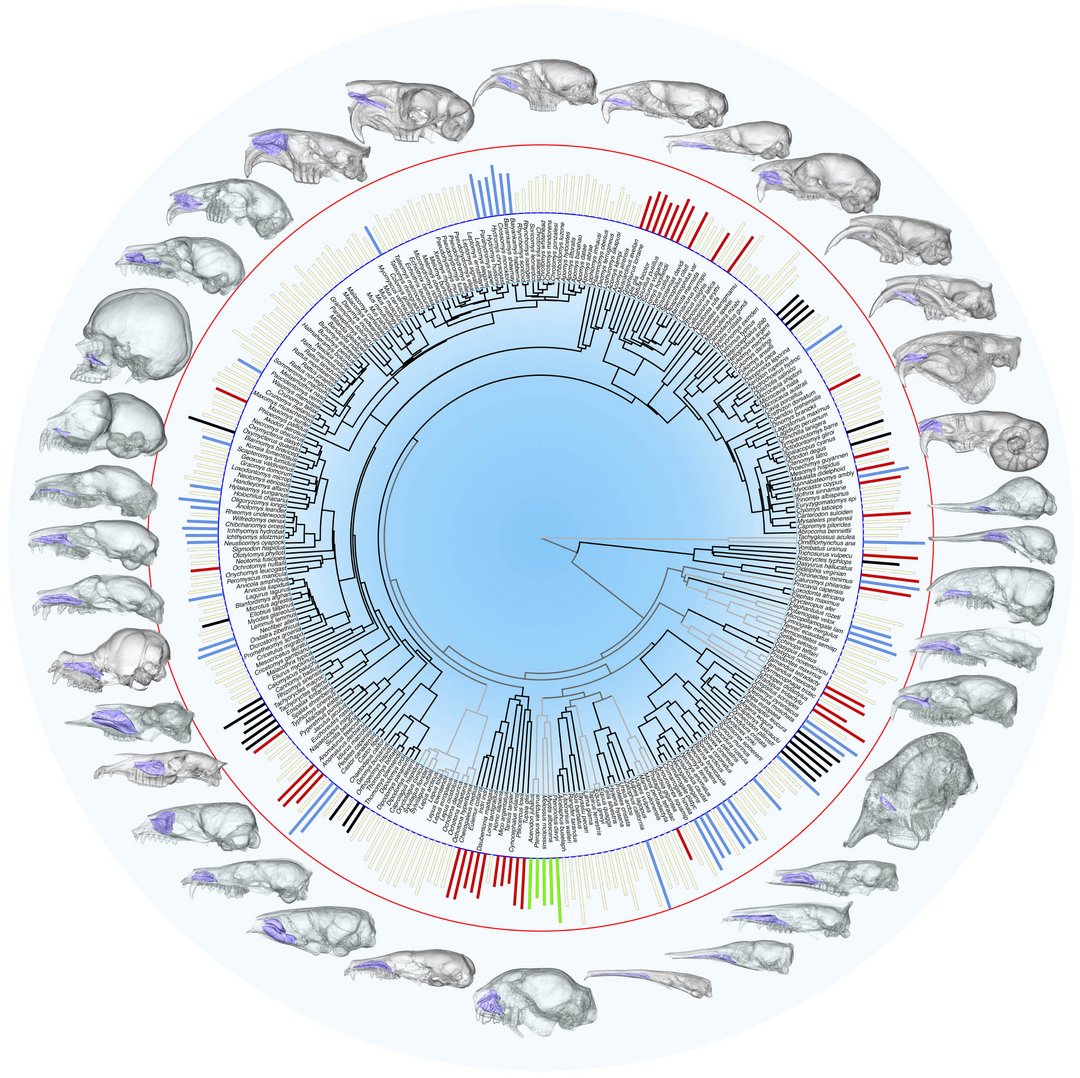16. Martinez, Q., Jan, O., Šumbera, R., Wright, M., Araújo, R., Braude, S., Hildebrandt, T. B., Holtze, S., Ruf, I., Fabre, P. H. (2023). Mammalian maxilloturbinal evolution does not reflect thermal biology. Nature Communications 14, 4425. doi.org/10.1038/s41467-023-39994-1
15. Martinez, Q., Amson, E., Ruf, I., Smith, T. D., Pirot, N., Broyon, M., Lebrun, R., Captier, G., Gascó Martín, C., Ferreira, G., & Fabre, P. H. (2023). Turbinal bones are still one of the last frontiers of the tetrapod skull: hypotheses, challenges and perspectives. PaleorXiv. doi.org/10.31233/osf.io/2gm95
14. Martinez, Q., Courcelle, M., Douzery, E., Fabre, P. H. (2023). When morphology does not fit the genomes: the case of rodent olfaction. Biology Letters, 19(4), 20230080. doi.org/10.1098/rsbl.2023.0080
13. Amson, E., Scheyer, T. M., Martinez, Q., Schwermann, A. H., Koyabu, D., He, K., & Ziegler, R. (2022). Unique bone microanatomy reveals ancestry of subterranean specializations in mammals. Evolution Letters. doi.org/10.1002/evl3.303
12. Ito, K., Kodeara, R., Koyasu, K., Martinez, Q., & Koyabu, D. (2022). The development of nasal turbinal morphology of moles and shrews. Vertebrate Zoology, 72, 857-881. doi.org/10.3897/vz.72.e85466
11. Martinez, Q., & Naas, A. (2021). Digest: New insight into sensory trade‐off in phyllostomid bats. Evolution. doi.org/10.1111/evo.14343
10. Vacher, J.-P., Chave, J., Ficetola, F., Sommeria-Klein, G., Tao S., Thébaud, C., Blanc, M., Camacho, A., Cassimiro, J., Colston, T. J., Dewynter, D., Ernst, R., Gaucher, P., Gomes, J. O., Jairam, R., Kok, P. J. R., Lima, J. D., Martinez, Q., Marty, C., Noonan, B. P., Nunes, P. M. S., Ouboter, P., Recoder, R., Rodrigues, M. T., Snyder, A., Marques-Souza, S., & Fouquet, A. (2020). Large scale DNA-based survey of Amazonian frogs suggest a vast underestimation of species richness and endemism. Journal of Biogeography, 47(8), 1781-1791. doi.org/10.1111/jbi.13847
9. Martinez, Q., Clavel, J., Esselstyn, J. A., Achmadi, A. S., Grohé, C., Pirot, N., & Fabre, P. H. (2020). Convergent evolution of olfactory and thermoregulatory capacities in small amphibious mammals. Proceedings of the National Academy of Sciences, 117(16), 8958-8965. doi.org/10.1073/pnas.1917836117
8. Privet, K., Vedel, V., Fortunel, C., Orivel, J., Martinez, Q., Cerdan, A., Baraloto, C., & Pétillon, J. (2020). Relative Efficiency of Pitfall Trapping vs. Nocturnal Hand Collecting in Assessing Soil-Dwelling Spider Diversity along A Structural Gradient of Neotropical Habitats. Diversity, 12(2), 81. doi.org/10.3390/d12020081
7. Martinez, Q., Lebrun, R., Achmadi, A. S., Esselstyn, J. A., Evans, A. R., Heaney, L. R., Portela Miguez, R., Rowe, C. K., & Fabre, P. H. (2018). Convergent evolution of an extreme dietary specialisation, the olfactory system of worm-eating rodents. Scientific reports, 8(1), 1-13. doi.org/10.1038/s41598-018-35827-0
6. Vacher J.-P., Kok P.J.R., Rodrigues M.T., Dias Lima J., Lorenzini A., Martinez Q., Fallet M., Courtois E.A., Blanc M., Gaucher P., Dewynter M., Jairam R., Ouboter P., Thébaud C. & Fouquet A. (2017). Cryptic diversity in Amazonian frogs: integrative taxonomy of the genus Anomaloglossus (Amphibia: Anura: Aromobatidae) reveals a unique case of diversification within the Guiana Shield. Molecular Phylogenetics and Evolution, 112, 158–173. doi.org/10.1016/j.ympev.2017.04.017
5. Courtois, E. A., Michel, E., Martinez, Q., Pineau, K., Dewynter, M., Ficetola, G. F., & Fouquet, A. (2016). Taking the lead on climate change: modelling and monitoring the fate of an Amazonian frog. Oryx, 50(3), 450-459. doi.org/10.1017/S0030605315000083
4. Fouquet, A., Martinez, Q., Zeidler L., Courtois E.A., Gaucher P., Blanc M., Dias Lima J., Marques Souza S., Rodrigues M. & Kok P.J.R. (2016). Cryptic diversity in the Hypsiboas semilineatus species group (Amphibia, Anura) with the description of a new species from the eastern Guiana Shield. Zootaxa, 4084(1), 79-104 doi.org/10.11646/zootaxa.4084.1.3
3. Fouquet A., Orrico V. Dill, Ernst R., Blanc M., Martinez Q., Vacher J.-P., Rodrigues M.T., Ouboter P., Jairam R., Ron S. (2015). A new Dendropsophus Fitzinger, 1843 (Anura: Hylidae) of the parviceps group from the lowlands of the Guiana Shield. Zootaxa, 4052(1), 39–64 . doi.org/10.11646/zootaxa.4052.1.2
2. Vedel, V., Cerdan, A., Martinez, Q., Baraloto, C., Petitclerc, F., Orivel, J., & Fortunel, C. (2015). Day-time vs. night-time sampling does not affect estimates of spider diversity across a land use gradient in the Neotropics. The Journal of Arachnology, 43(3), 413-416.
1. Fouquet A., Martinez Q., Courtois E. A., Dewynter M., Pineau K., Gaucher P., Blanc M., Marty C., Kok P. J. R. (2013). A new species of the genus Pristimantis (Amphibia, Craugastoridae) associated to the modest uplands of French Guiana. Zootaxa, 3750(5):569-586. doi.org/10.11646/zootaxa.3750.5.8


